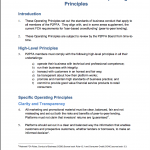Financial Stability and Shadow Banking
Posted December 10, 2015
Federal Reserve Vice Chair Fischer delivered remarks at the “Financial Stability: Policy Analysis and Data Needs” 2015 Stability Conference sponsored by the Federal Reserve Bank of Cleveland and the Office of Financial Research. Here is discussed financial stability and shadow banking.
Vice Chair Fischer believes that there are “five factors that contribute to financial fragility”: (a) high debt burdens at households and firms; (b) elevated leverage and maturity transformation within the financial sector; (c) complexity and interconnectedness in intermediation chains; (d) low risk premiums on assets, especially assets funded with debt; and (e) complacency on the part of investors, supervisors and decision-makers in the private sector of the financial system.
During Vice Chair Fischer’s presentation he offered an assessment of vulnerabilities in the financial system; and identified gaps in the current understanding of conditions inside and outside of the banking sector that should be addressed by regulators and researchers.
He stated, “An essential element of [the federal regulatory] infrastructure is learning the lessons of history – both the lessons of what happened, and the fact that supervisors and regulators will on occasion be surprised”.
Mr. Fischer made the following assertions regarding what needs to be understood to monitor financial stability:
- A Closer Look at Shadow Banking: The reduction in leverage and maturity transformation associated with better regulations leaves the financial system “much more resilient – even if such regulations have modestly affected market liquidity.”
- What We Know and What We Do Not: Data on a range of activities – including securities lending, bilateral repos, and derivatives trading – that create funding and leverage risks “remain inadequate and hence could prove destabilizing if sufficiently large or widespread.”
- Data Are Not Enough: We Need Theory Too: An “important area in need of development” is economic modeling on interconnectedness, particularly on the interaction of shadow banking, banks and the broader financial system. Further, research that distinguishes between banks and nonbanks, or highlights how their interactions are driven by economic incentives, could guide regulator efforts to collect data and set policies to limit possible instabilities associated with interconnectedness.
Though Vice Chair Fischer made no mention of the alternative investment landscape of P2P Lending, it will be interested to see where Peer -to- Peer Lending Marketplaces will be placed as related to shadow banking as a contributor to financial stability in the coming years.




